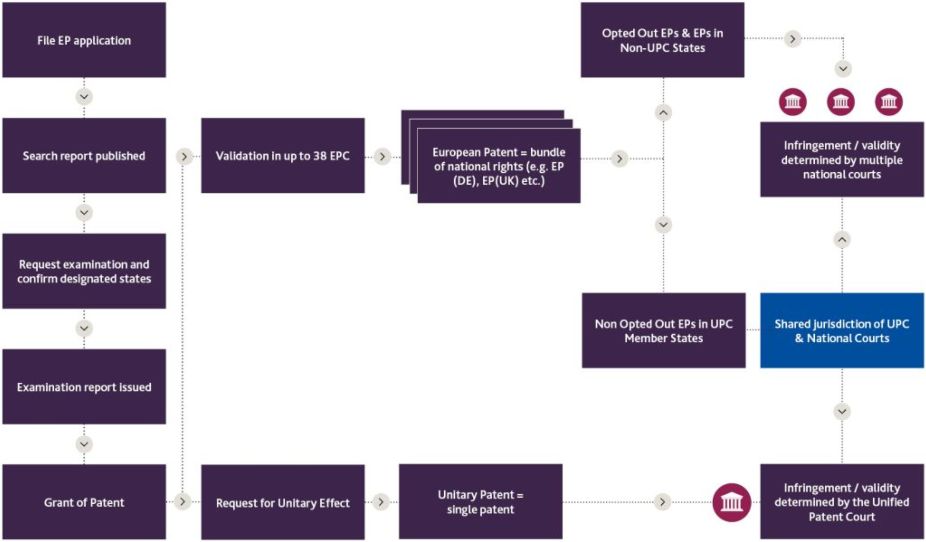Welcome to Gowling WLG's Unified Patent Court (UPC) & Unitary Patent hub
The arrival of the Unitary Patent and the Unified Patent Court is the biggest development in European Patent law and practice for nearly 50 years. The introduction of a Unitary Patent system providing protection across all participating EU member states, and a litigation system allowing for pan-European injunctions and damages awards, is a huge step. Cross-border protection and enforcement of patent rights has not been seen on this scale anywhere in the world before now.
Everyone who deals with patents in the European market, whether by way of enforcement, licensing or assessing the risk of potential infringements, needs to understand how the UPC system will work and to prepare for its arrival now.
Our international team of UPC specialists provides an easy-to-follow guide to the UPC system and Unitary Patent. If you would like to contact our UPC specialists for an initial discussion about what it might mean for your country, please do get in touch with us.
WHAT, WHY, WHERE, WHEN?
The UPC offers flexibility by providing for an additional 'European' forum to complement the enforcement of national patents in national courts. It introduces a federal system of patent litigation to Europe, aligning the European market with other major economies such as China and the United States.
Classical European Patents (EPs) are a collection of national rights. Before the UPC comes into force, European Patents, therefore, have to be enforced and invalidated in each individual country where that European Patent has been designated.
This results in patentees having to pay renewal fees to each national patent office for which the patent remains designated (validated) and makes multi-jurisdiction litigation a costly and time-consuming exercise. It is also common for different national courts to take different views on infringement, validity or both. The UPC and Unitary Patent are separate measures that are intended to address this:
- The UPC system permits the validity and infringement of European Patents (subject to opt-out) in all participating member states to be determined via a single action before one of the UPC courts. This allows patentees to obtain an injunction across all UPC participating countries and past damages for all sales across the same territory. A potential infringer can also file a revocation action with the UPC to cancel all parallel European Patents (e.g. EP(DE), EP(FR) etc.) in force in each of the UPC participating countries in a single action.
- The newly created European Patent with Unitary Effect (Unitary Patent) provides patentees with an alternative to the classical European Patent. A Unitary Patent is a single unitary right that is more cost-effective than obtaining a European Patent designated for more than a small number of states. Unitary Patents are subject to the exclusive jurisdiction of the UPC, meaning that patentees must bring all actions relating to their infringement or validity in the UPC.
The UPC system will eventually apply across most European Union member states. However, when the UPC system comes into effect, not all UPC participating member states will have ratified. The coverage of a Unitary Patent right and the ability to litigate before the UPC will be limited to those member states that have ratified.
The UPC system may come into force as early as the second half of 2022 but companies should be taking preparatory steps now.
How is the UPC similar to Chinese or US Patent
Litigation?
In countries such as the United States or China, a patent holder
can conduct patent litigation in any one of a number of local
patent courts, but the result applies to the entire territory
covered by the patent.
For example, a US patentee will choose to enforce its US patent in
one of many District Court(s) which will determine the outcome of
the litigation (infringement and validity), but the resulting
outcome is applicable across the whole of the United States. The
patent holder does not have to sue the defendant in every state
where the defendant is infringing.
The UPC operates in a similar manner – litigation will take
place before a single local court, but the outcome will be binding
in all participating member states.
Explore the UPC with our interactive map.
View map
THE UPC & UNITARY PATENT SYSTEM
How it works

UPC FAQs
Essential information to connect the dots
What is the timeline between now and the start of the UPC?
- It could commence as early as "second half of 2022"
- It is possible to opt-out your European Patents out of the UPC System by filing for an "opt-out", starting about 3 months before the commencement of the UPC.
- Our UPC blog publishes all key time points.
How do you Opt-Out of the European Patent?
- The default position is that, on the day the UPC comes into operation, every European patent and European patent application with designation(s) in UPC countries will already be "in" the UPC system.
- If you wish to opt-out of the UPC system, then you must identify the European patent/applications. If you own a large number of portfolios, this could require time.
- Opting out co-owned or licensed European patent/applications/patent families (even within the same group) could require agreement of relevant proprietors and licensees.
What are the cost savings if I applied for a Unitary Patent instead of applying for classical European patents or national patents?
- Whether any cost savings may be achieved could depend on the number of territories that need to be designated as well as the length and complexity of the patent.
- This is a potentially complex calculation involving initial fees, renewal fees and other costs.
- Costs include costs of validation, translation as well as renewal fees balanced against the inability to reduce the territorial scope of patent protection to reduce renewal fees in the case of a UP as the years progress (in contrast, the coverage of EP can be reduced by not paying the renewal fees for less important territories).
What is the Court Structure of the UPC? Who makes the decisions?
- The UPC will consist of a decentralised Court of First Instance located across at least 11 Member States, a Court of Appeal (Luxembourg) and a Registry. Questions of interpretation of law may be referred to the Court of Justice of the European Union, whose decision will be binding.
- The panel of Judges at the UPC will be multinational in composition and will include both legally and technically qualified judges.
- The language of the proceedings would depend on the member state which is hosting the court in which the dispute is being heard or in a claim for the revocation of a patent/ declaration of non-infringement, the proceedings will be held in the language in which the patent was granted. There may be a choice of languages, and parties may agree on a particular language, if the court agrees. Most first instance courts are expected to have the ability to operate in English if required.
What is the Litigation Procedure going to be like at the UPC?
- The UPC is capable of making all the usual orders that a national patent court can make, including provisional measures and injunctions which will cover the territories of the European Patents of a UP that are litigated.
- The UPC procedure is comprised of three stages; written procedure, interim procedure and oral procedure. It is estimated that a typical case might take about 12 months from issue to trial.
- The procedural steps some very clearly common law-based principles such as the availability of discovery/disclosure, expert evidence, and cross-examination.
How much does it cost?
- As ever, the cost of an action will depend on the nature and complexity of the claim.
- The costs of litigating in the UPC will be comprised of attorney's fees (including disbursements) and court fees. The court fee comprised of (i) a fixed fee; and (ii) value-based fee for actions valued at more than EUR 500,000. The fixed fee is payable on issue of the claim whereas the value-based fee is paid at the interim conference (approx. 3 months after issue) which means issuing proceedings will be relatively cost effective.
- The UPC will recognise costs shifting in favour of a successful party, allowing it to recover a portion of its attorney's fees. The recoverable portion is determined according to a scale relative to the value of the claim.
I do not get involved in patent litigation, why should I care?
- Litigation is rarely a choice. Understanding this new system and how to deploy it as part of a defensive litigation strategy could be the difference between defending one set of proceedings in the UPC, or multiple proceedings throughout Europe.
- The UPC has an impact corporate transactions such as licensing, acquisitions or security arrangements.
HOW TO MOVE FORWARD
Expertise on hand
OUR INTERNATIONAL APPROACH
Although the UPC represents a new additional forum, it does not need to be a step into the complete unknown. The UPC is a product of international cooperation based on the rules, experience and approaches of national patent courts across Europe (including the UK, Germany and France). Gowling WLG believes that UPC litigants should be able draw on the experience of an international team that is familiar with all of these systems to ensure that all angles are covered.
That is why our UPC specialists include lawyers from The UK, Germany and France, all of whom have built strong relationships with patent lawyers across Europe.
How we can help:
- How to navigate the opt-out;
- Deciding whether to incorporate the UPC into your international / European patent enforcement strategy – i.e. whether to use the UPC, national patent courts or both;
- How and where to start a UPC action and manage the risk of bifurcation of infringement / revocation actions;
- How to effectively manage the risk of being sued in the UPC;
- Using the UPC to 'clear the way' via revocation actions and protective measures;
- UPC litigation strategy, including the availability of provisional measures and preliminary relief (such as injunctions), discovery and evidence, and the scope of final relief such as declaratory relief and final injunctions;
- Guidance as to the costs of patent actions in the UPC; and
- Drafting and amending exclusive licences, collaboration agreements and co-ownership arrangements to accommodate provisions dealing with control over the opt-out and right to issue proceedings in the UPC.
"Read the original article on GowlingWLG.com".
The content of this article is intended to provide a general guide to the subject matter. Specialist advice should be sought about your specific circumstances.





